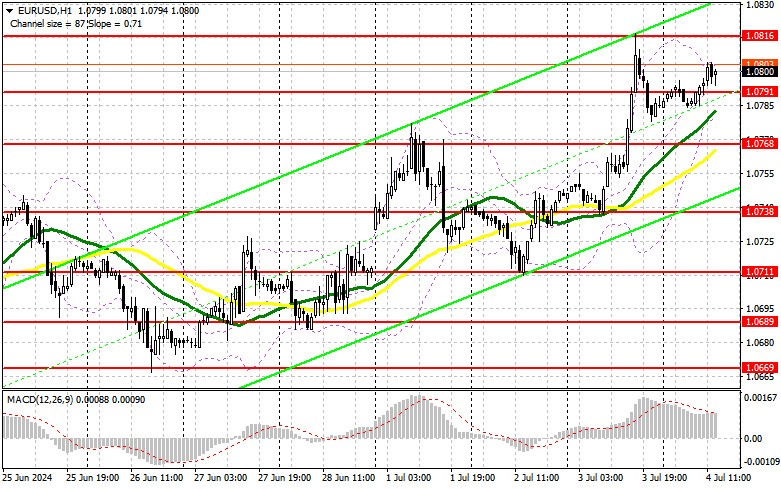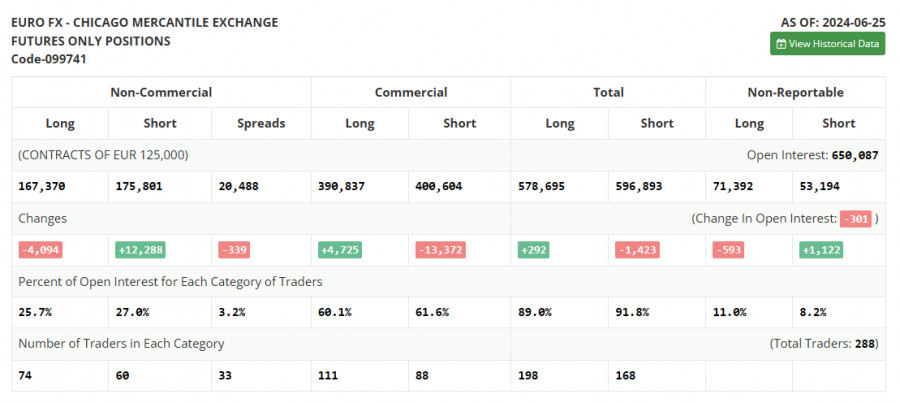
In my morning forecast, I drew attention to the level of 1.0719 and planned to make market entry decisions based on it. Let's look at the 5-minute chart and analyze what happened. Trading around 1.0791 did not provide a suitable entry point into the market, so I was left without signals in the first half of the day. The technical picture for the second half of the day still needs to be revised.

To open long positions on EUR/USD, the following is required:
Very good data from the eurozone yesterday maintained the purchasing power of the euro. However, today is Independence Day in the USA, so all American markets will be closed, leading to lower trading volumes and volatility. For this reason, it is better to act strictly within the bounds of the sideways channel and focus on daily highs and lows. Additionally, no US statistics are being released today, which is understandable. A decline and a false breakout formation at 1.0791 will be a suitable entry point for long positions with the target of recovering the euro towards the 1.0816 area – the weekly high from which the pair already declined actively yesterday. A breakout and subsequent test from above of this range will strengthen the pair with a chance to rise to the resistance at 1.0852. The furthest target will be the high at 1.0880, where I will be taking profits. Testing this level will allow for the establishment of a new bullish trend. In the event of a decline in EUR/USD and no activity around 1.0791 in the second half of the day, I will only enter after a false breakout formation in the area of the next support at 1.0768, where the moving averages that favor the bulls are located. I plan to open long positions immediately on a bounce from the low of 1.0738 with the target of a 30-35 point upward correction within the day.
To open short positions on EUR/USD, the following is required:
Sellers are not in a hurry to return to the market yet. Only their active stance around the nearest resistance at 1.0816, where the pair is currently heading, combined with a false breakout, will provide a suitable entry point for short positions, targeting a new decline of the pair towards the support at 1.0791, which acts as a sort of midpoint of the intraday sideways channel. A break and consolidation below this range, along with a retest from below, will give another selling point, moving towards the minimum at 1.0768, where I expect to see a more active bullish presence. The furthest target will be the area of 1.0738, where I will be taking profits. In the event of an upward movement in EUR/USD in the second half of the day and the absence of bears at 1.0816, which is unlikely due to the holiday, buyers will be able to achieve further growth of the pair. In this case, I will postpone sales until the next resistance at 1.0852 is tested. I will also sell there, but only after an unsuccessful consolidation. I plan to open short positions immediately on a rebound from 1.0880, targeting a downward correction of 30-35 points.

In the Commitment of Traders (COT) report for June 25, there was an increase in short positions and a decrease in long positions. The policies implemented by the Federal Reserve System and the European Central Bank continue to affect risky assets. The fact that people still need to plan to change these policies will further strengthen the dollar. The COT report indicated that long non-commercial positions decreased by 4,094 to 167,370, while short non-commercial positions increased by 12,288 to 175,801. As a result, the spread between long and short positions decreased by 339.
Indicator Signals:
Moving Averages
Trading is conducted above the 30 and 50-day moving averages, indicating a potential rise in the euro.
Note: The period and prices of the moving averages are considered by the author on the hourly chart H1 and differ from the general definition of classical daily moving averages on the daily chart D1.
Bollinger Bands
In case of a decline, the lower boundary of the indicator at around 1.0775 will serve as support.
Indicator Descriptions
Moving average: Determines the current trend by smoothing out volatility and noise. Period: 50. Marked in yellow on the chart.Moving average: Determines the current trend by smoothing out volatility and noise. Period: 30. Marked in green on the chart.MACD Indicator (Moving Average Convergence/Divergence): Fast EMA period 12. Slow EMA period 26. SMA period 9.Bollinger Bands: Period: 20.Non-commercial traders are speculators such as individual traders, hedge funds, and large institutions that use the futures market for speculative purposes and meet certain requirements.Long non-commercial positions: Represent the total long open position of non-commercial traders.Short non-commercial positions: Represent the total short open position of non-commercial traders.Total non-commercial net position: The difference between the short and long positions of non-commercial traders.